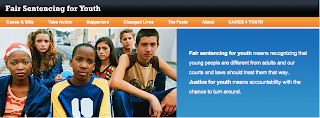Our posts about SB9 yielded several reader comments, some of which I had to refrain from publishing because of their incendiary tone. I thought it might be worthwhile to tackle some of the misapprehensions regarding SB9. While I think SB9 is a great idea and endorse it wholeheartedly, I am not officially affiliated, politically or financially, with Senator Yee or anyone else involved. Therefore, consider this an academic’s opinion, rather than political propaganda.
This proposal sets dangerous people loose in the streets.
The proposal addresses only two hundred inmates or so, and none of them is being set loose in the street quite yet. What the bill does is allow a judge to review again the case of juveniles sentenced to LWOP after they have already served at least a fifteen-year sentence. And even then, the judge will only have the ability to modify the sentence to twenty-five to life. Overall, it’s a fairly mild proposition.
Aren’t these people dangerous?
Well, some of them might be, and some of them might not. It will be up to the judge to review their history, when petitioned to do so, and to assess whether it is risky to make them eligible for parole. There will be discretion about this. What we know about the trajectory of criminal careers tends to suggest that, for many folks who committed crime in their teens, age tends to “mellow people out” and they become less dangerous as they age.
If it’s only a few hundred people, why is this such a big deal?
In the grand scheme of things, it’s not a big deal at all. A handful of inmates will be serving a very long prison term, rather than an even longer one. But the difference to the individual, in terms of offering a ray of hope, is immense.
Doesn’t that teach juveniles that it’s okay to murder?
Not at all. Twenty-five to life is a very long time for a young person. And that’s assuming that juveniles even think about the repercussions when committing crimes, many of which are expressive crimes rather than cold, calculated ones.
We’re not really saving a lot of money by letting these people out earlier than expected, are we?
That’s impossible to answer accurately without proper data. However, it stands to reason that the older our inmate population is, the more we’ll be spending on its health care, which is already approximately one third of our correctional budget. Letting someone out when he or she is in his or her fifties, rather than letting him or her die behind bars, might spare us some of the costlier inmates and allow us to focus resources on others who need urgent care.
They committed murder and deserve never to see the light of day again.
Well, that is a legitimate opinion, but what someone “deserves” depends on your definition of just desert. Spending twenty-five to life behind bars, subject to violence, overcrowding, and prisons devoid of rehabilitative programming is very far from being a walk in the park.
What about the victims’ families?
That is very much a matter of personal feeling. Many families of murder victims feel immense amounts of rage and sadness and translate those to a wish that the perpetrator of their tragedy rot behind bars. That is understandable. But it doesn’t mean that the state has to grant these wishes to the letter. Moreover, there are plenty of families of victims who do not derive satisfaction from revenge or retribution, and would much rather the money spent on incarceration be spent on more and better homicide investigation, to prevent future tragedies. There are many people who feel this way; the media exposes you to the vocal, angry ones, and they do not necessarily represent everyone.
If the legislators think LWOP sentences should be reviewed, why not abolish LWOP for juveniles altogether?
At this point, Supreme Court case law regards LWOP for juveniles as constitutional for murder (not for other offenses.) Maybe future cases will follow the rationale of Roper v. Simmons and extend the abolition of LWOP to murder as well. But this is an opportunity to do something, now.
For a matter pertaining to so few people, this is eating up plenty of public energy and discourse. Why are we dealing with this, rather than with death penalty abolition and fighting mass incarceration?
Because this is easier to achieve, and these folks need some attention, too. But there is a bill on the CA ballot to abolish the death penalty. There’s also a bill to reform the Three Strikes Law. And it’s about time.



